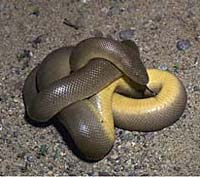Rubber boa facts for kids
Quick facts for kids Rubber boa |
|
|---|---|
 |
|
| Conservation status | |
| Scientific classification | |
| Kingdom: | |
| Phylum: | |
| Subphylum: | |
| Class: | |
| Order: | |
| Suborder: | |
| Family: | |
| Subfamily: |
Erycinae
|
| Genus: |
Charina
|
| Species: |
C. bottae
|
| Binomial name | |
| Charina bottae (Blainville, 1835)
|
|
| Synonyms | |
|
|
The rubber boa (Charina bottae) is a special type of snake. It belongs to the boa family and lives in North America. This snake is known for its unique look and gentle nature.
Contents
About the Rubber Boa
Rubber boas are some of the smallest boas around. Adult snakes can be from 38 to 84 centimeters (about 15 to 33 inches) long. Newborns are much smaller, usually 19 to 23 centimeters (7.5 to 9 inches) long.
What Does It Look Like?
The snake's name comes from its skin. It often looks loose and wrinkled, like rubber. Its scales are small, smooth, and shiny. This gives the snake a rubbery feel and appearance.
Most rubber boas are tan to dark brown. Their bellies are usually lighter in color. Some can even be olive-green, yellow, or orange. Baby boas often look pink and a bit see-through. They get darker as they grow older.
Rubber boas have small eyes with pupils shaped like thin lines. Their heads are short and blunt, not wider than their bodies. A cool fact about them is their tail. It's short and blunt, looking very much like their head! This makes them easy to spot.
Where Do Rubber Boas Live?
Rubber boas live further north than any other boa species. Their home covers a big part of the western United States. You can find them from the Pacific Coast all the way to western Utah and Montana.
They live as far south as the San Bernardino and San Jacinto Mountains in California. Their northern range reaches into southern British Columbia in Canada. Sometimes, they are even seen in Colorado and Alberta.
These snakes are common in California, Oregon, Washington, Nevada, Utah, Wyoming, Montana, and Idaho. Their ability to live in these northern areas makes them unique among boas.
Rubber Boa Homes
Rubber boas can live in many different places. They are found in grasslands, meadows, and chaparral areas. They also live in deciduous and conifer forests. Some even live high up in mountains, over 3,000 meters (10,000 feet) high.
These snakes do not like very hot and dry places. But they can live in surprisingly cold areas for a snake. They spend a lot of time hiding under rocks, logs, or leaves. They also use burrows made by other animals.
Because of this, their homes must offer plenty of places to hide. They also need enough warmth, moisture, and food. Scientists believe rubber boas usually stay in a small area. However, they might move if they need more food or space.
Rubber Boa Behavior
Rubber boas act differently from many other snakes. They are known as one of the calmest boa species. People often use them to help others get over their fear of snakes.
These snakes are known to never bite or strike at humans. If they feel scared, they might release a strong smell from their body. This musk helps them scare away threats.
When Are They Active?
Rubber boas are mostly active at night. They are also often active during dawn and dusk. This is one reason why people rarely see them. Because they live in cooler places, rubber boas hibernate during winter. They sleep in dens underground to stay warm.
How They Hunt
Rubber boas mainly eat young mammals. This includes shrews, voles, and mice. When they find a nest of baby mammals, they try to eat all of them. They use their tail to push away the mother animal. This is why many rubber boas have scars on their tails.
They also eat snake eggs, lizard eggs, and lizards. Sometimes, they even eat young birds or young bats. There have even been cases of them eating other snakes.
How They Stay Safe
Many animals in their habitat might try to eat rubber boas. When a rubber boa feels threatened, it curls into a ball. It hides its head inside the ball and sticks out its tail. The tail looks like its head, which can confuse predators.
While this trick helps, it doesn't always work against bigger predators. These include raptors, coyotes, raccoons, and cats. The best way rubber boas stay safe is by staying hidden. They are very good at being secretive.
Reproduction and Life Cycle
Rubber boas are viviparous. This means they give birth to live young, instead of laying eggs. A female can have up to nine babies at once. However, many females only have babies every four years.
Mating happens in the spring, soon after they wake up from hibernation. The baby snakes are born later that year, usually between August and November.
Images for kids
-
A young rubber boa in Oregon, shown with a US nickel for size comparison.
See also
 In Spanish: Boa de goma del norte para niños
In Spanish: Boa de goma del norte para niños




